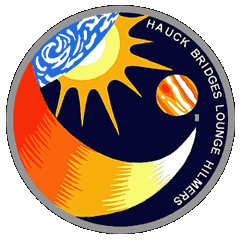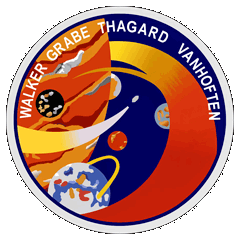Return to Sender: Post-Challenger Cancelled Space Shuttle Missions
- Aeryn Avilla
- Jul 12, 2023
- 8 min read
Updated: Mar 20
In November of 1985, NASA released a list of forty-four upcoming Space Shuttle missions in the NASA Mixed Fleet Flight Manifest (MFFM). These missions, beginning with STS-61E in March of 1986 and ending with STS-81N in August of '88, would have included a variety of payloads, both military and civilian, and some interesting payload specialists. Following the STS-51L Challenger disaster in January of 1986, some of these missions were significantly delayed while others were cancelled altogether. This post looks at a few Shuttle missions in the MFFM with unique payloads and crew members that were either re-manifested in the late 1980s or abandoned.
Patches of cancelled missions STS-61E, STS-61F, and STS-61G (seasky.org)
Howdy, Halley
The flight immediately following STS-51L Challenger would have been STS-61E Columbia with the primary payload ASTRO-1. Set to launch on March 6, 1986, ASTRO-1 was an observatory aimed at making astronomical observations of Halley's Comet as it journeyed through the inner solar system. It consisted of three ultraviolet telescopes; the Hopkins Ultraviolet Telescope, the Ultraviolet Imaging Telescope, and the Wisconsin Ultraviolet Photopolarimeter Experiment. The trio was mounted on two Spacelab experiment pallets and attached to the Instrument Pointing System, which was located in the orbiter's payload bay and oriented the telescopes towards the comet. The crew would have consisted of commander Jon McBride, pilot Richard Richards, mission specialists Bob Parker, David Leetsma, and Jeff Hoffman, and payload specialists Sam Durrance and Ronald Parise. When the mission was re-manifested as STS-35, Vance Brand replaced McBride as commander, Guy Gardner replaced Richards as pilot, and Mike Lounge replaced Leetsma as a mission specialist. ASTRO-1 flew in 1990, though it did not observe Halley's comet.


Death Star
STS-61F Challenger and STS-61G Atlantis would have launched the Ulysses and Galileo Jovian probes in the spring of 1986. These spacecraft utilized Shuttle-Centaur, a derivative of the Centaur upper stage designed to fit in the orbiter's payload bay and launch satellites into high Earth orbits and probes into deep space. Galileo and Ulysses used Centaur G-Prime while the Department of Defense's (DoD) Milstar communications satellites and the Magellan Venusian probe would have used the Centaur G, a shortened variant of the G-Prime. STS-61F and STS-61G were the most dangerous Shuttle missions planned— some astronauts even dubbed Centaur the "Death Star". The main safety issue involved the abort procedure for these two missions: Astronauts were concerned about fuel leaks and explosions since the valves used to drain propellant from the Centaur prior to landing the orbiter were located on both sides of the orbiter's fuselage in close proximity to the Space Shuttle Main Engines and the Orbital Maneuvering System. Additionally, landing with Centaur still in the payload bay shifted the orbiter's center of gravity further aft than on previous missions. Although Ulysses and Galileo did not use Centaur when they launched in 1990 and 1989, Centaur was used with the Titan IV rocket.
STS-61F would have launched on May 15, 1986 to deploy Ulysses. This would have been the first use of the Centaur G-Prime. Due to the dangerous nature of the flight, it had a crew of four rather than seven— commander Frederick Hauck, pilot Roy Bridges, and mission specialists David Hilmers and Mike Lounge. Ulysses launched on STS-41 in October of 1990 with an entirely different crew. STS-61G would have launched on May 20, only one day after the prior mission's return, and would have been crewed by commander David Walker, pilot Ronald Grabe, and mission specialists Norm Thagard and James "Ox" Van Hoften. Unlike Ulysses, Galileo caused some controversy when it launched onboard STS-34 in October of 1989: Some anti-nuclear groups believed the plutonium in Galileo's radioisotope thermoelectric generators posed a risk to the public's safety should a tragedy like the Challenger disaster occur again.
The crews of STS-61F and STS-61G (spacefacts.de)
American Interkosmos
STS-61H Columbia would have launched on June 24, 1986, to deploy three satellites; an American Westar-6S communication satellite, a British Skynet-4A military communication satellite, and an Indonesian Palapa B3 commercial satellite. The foreign satellites would have been accompanied by international astronauts [1]. The British payload specialist was Nigel Wood, a Royal Air Force pilot and one of four British astronauts selected by the Ministry of Defense to accompany the Skynet 4 military satellites as they launched on the Shuttle. The Indonesian payload specialist was Pratiwi Sudarmono, the holder of a Ph.D. in molecular biology from Osaka University in Japan. In addition to accompanying the Palapa B3 satellite, she would have performed experiments involving the human body's physiological endurance of spaceflight. Had STS-61H flown, Wood and Sudarmono would have been the first British and Indonesian astronauts [2]. After the Challenger disaster, deployment of commercial satellites using the Shuttle was terminated and the foreign satellites scheduled to launch on STS-61H were launched separately on expendable vehicles in 1987 and 1990. The American crew— commander Michael Coats, pilot John Blaha, and mission specialists Anna Fisher, James Buchli, and Robert Springer— participated in a 32-hour long mission simulation known as STS-61MT.
Pratiwi Sudarmono (right) with backup Taufik Akbar; Nigel Wood (left) with backup Richard Farrimond (spacefacts.de)
Hubble Huggers
STS-61J Atlantis would have launched on August 18, 1986 to deploy the Hubble Space Telescope. The mission would have been commanded by legendary astronaut John Young, the Chief of the Astronaut Office and veteran of six prior spaceflights (including Apollo 16, during which he walked on the moon). Remaining crew members would have been pilot and future NASA Administrator Charlie Bolden and mission specialists Kathy Sullivan, Steve Hawley, and Bruce McCandless. Loren Shriver replaced Young as commander of the Hubble deployment mission STS-31 in 1990.

Walter Cronkite Goes to Space
STS-61I Challenger was scheduled to launch on September 27, 1986 with the primary mission objective of retrieving the Long Duration Exposure Facility (LDEF), a spacecraft that held more than fifty experiments from countries around the world and was deployed by STS-41C in April of 1984. The crew would have consisted of commander Donald Williams, pilot Mike Smith [3], and mission specialists James Bagian, Bonnie Dunbar, and Sonny Carter [4]. An unannounced Indian national would have flown as payload specialist to accompany the Indian INSAT 1-C communication satellite, which later launched on a European Ariane 3 in 1988. The second payload specialist would have been a civilian journalist. The Journalist in Space Project was similar to the Teacher in Space Project and sought to inform the general public about spaceflight by sending a credible journalist on STS-61I. Forty finalists were announced in May, including Jay Barbree, a southeastern correspondent for NBC News based in Cocoa Beach, Florida and the only journalist to have covered every American non-commercial human space mission [5], and "the most trusted man in America" Walter Cronkite. The project was suspended indefinitely in July and never revived [6]. When the LDEF was retrieved by STS-32 in 1990, Bonnie Dunbar was the only original crew member.
Walter Cronkite with model Lunar Module prior to the landing of Apollo 11 in July of 1969 (CBS)
Jay Barbree in front of final Shuttle mission STS-135 Atlantis in July of 2011 (NBC)

Blue Shuttle
The Department of Defense also had big plans for the Space Shuttle and established the Manned Spaceflight Engineer (MSE) program to train American military personnel as payload specialists for DoD-dedicated Shuttle missions. Of the forty-four missions included in the NASA MFFM, twenty-two would have deployed DoD payloads and included at least one MSE per crew. After the Challenger disaster, NASA was more concerned with making spaceflight safe again than it was with the MSE program. Administrator James C. Fletcher expressed the desire to fly five-member crews and potentially eliminate the position of "payload specialist". By the end of 1987, the cadre of thirty-two MSEs was reduced to ten, and the program officially ended in 1988 primarily due to lack of need for crewed DoD missions. Only two officers flew as part of the program— Gary Payton on STS-51C Discovery and William Pailes on STS-51J Atlantis in 1985.
The DoD was also interested in flying polar orbital Shuttle missions. These flights could not launch from the Kennedy Space Center in Florida because they would have flown over populated areas along the southeastern United States. Additionally, the external fuel tank would have traveled over not only Canada but Soviet Russia and possibly China. Space Launch Complex 6 (SLC-6 or "Slick Six") was constructed at Vandenberg Air Force Base (now Space Force Base) in California in the mid-1960s to support Titan III launches for the Manned Orbiting Laboratory program. It was refurbished and upgraded in the '80s for the Space Shuttle, and four missions launching from the complex appeared on the NASA Mixed Fleet Flight Manifest. The planned inaugural flight was to be STS-62A Discovery launching in March of 1986 to deploy Teal Ruby, an experimental early warning satellite. The mission also would have performed a series of Earth atmospheric observations using telescopes and instruments in the orbiter's payload bay. Payload specialist #2 was Brett Watterson, an MSE from the first class of DoD astronauts. Under Secretary of the Air Force and NRO Director Pete Aldridge was payload specialist #1. After the mission was cancelled post-Challenger, STS-62A's pilot and two mission specialists (Guy Gardner, Mike Mullane, and Jerry Ross) flew STS-27 in 1988.

The final mission in the NASA MFFM was STS-81N Atlantis, a DoD mission with the target launch date of August of 1988. STS-26 Discovery, NASA's return to flight after Challenger, launched in September. There are more missions scheduled for 1986, '87, and '88 that were assigned crews and payloads not covered in this post.
Author's note: I am planning on publishing a post specifically about Shuttle Centaur later this year and would like to write a post about the Journalist in Space Project in the future. Thanks for reading and be sure to like and share this post!
[1] At the time, West Germany, Canada, France, Saudi Arabia, the Netherlands, and Mexico had citizens fly on the Space Shuttle.
[2] Sudarmono also would have been the first woman to be a country's first citizen in space. The first British person to fly in space was Helen Sharman in 1991 (who also claimed Sudarmono's would-be title of first woman to be a country's first citizen in space). Indonesia has yet to send a national into space.
[3] Mike Smith was the pilot of the ill-fated STS-51L Challenger and the only member of the crew to have been assigned another mission prior to the disaster.
[4] Sonny Carter flew on STS-33 in 1989 and was killed during the crash of Atlantic Southeast Airlines Flight 2311 in Brunswick, Georgia on April 5, 1991 while traveling for NASA. At the time, he was on the crew of STS-42.
[5] 166 crewed space missions launched between 1961 (Mercury-Redstone 3 Freedom 7) and 2011 (STS-135 Atlantis). At the time of Barbree's death in May of 2021, three American commercial spaceflights had launched— SpaceX Demo 2, US Crew Vehicle 1, and US Crew Vehicle 2.
[6] Japanese journalist Toyohiro Akiyama became the first journalist to fly in space onboard the Interkosmos Soyuz TM-11 mission in 1990.
Bibliography
Avilla, Aeryn. "Blue Shuttle: The Manned Spaceflight Engineer Program." SpaceflightHistories. 24 Jan. 2022, https://www.spaceflighthistories.com/post/manned-spaceflight-engineer
Carney, Emily. "A Deathblow to the Death Star: The Rise and Fall of NASA's Shuttle-Centaur." ArsTechnica. 9 Oct. 2015, https://arstechnica.com/science/2015/10/dispatches-from-the-death-star-the-rise-and-fall-of-nasas-shuttle-centaur/
Evans, Ben. "In the Shadow of Challenger: The Lost Mission of STS-61E (Part 1)." AmericaSpace. 2013, https://www.americaspace.com/2013/03/09/in-the-shadow-of-challenger-the-lost-mission-of-sts-61e-part-1/
Evans, Ben. "'Neat People': The Unflown International Mission of STS-61H (Part 1)." AmericaSpace. 2014, https://www.americaspace.com/2014/06/21/neat-people-the-unflown-international-mission-of-sts-61h-part-1/
Lethbridge, Cliff. "Space Shuttle Missions Canceled or Remanifested Following STS-51L." Spaceline. https://www.spaceline.org/united-states-manned-space-flight/challenger-legacy-index/space-shuttle-missions-canceled-remanifested-sts-51l/
Mayer, Hannes. "The Mod Payload Specialists — When Britain had an Astronaut Corps." International Astronautical Federation. 2016, https://iafastro.directory/iac/archive/browse/IAC-16/E4/1/31815/
"STS-61H/61MT." http://www.mach25.nl/~jacques/shuttle/STS61H.html
Yuniar, Nanien. "The Story of Pratiwi Sudarmono Becoming the First Female Astronaut." Antara Sulteng. 20 Sep. 2020, https://sulteng.antaranews.com/berita/154117/kisah-pratiwi-sudarmono-jadi-astronaut-perempuan-pertama


















